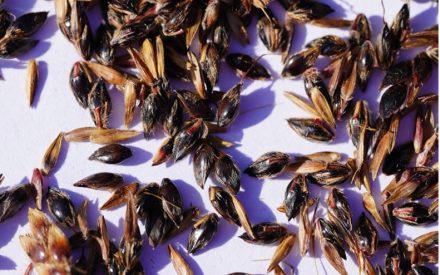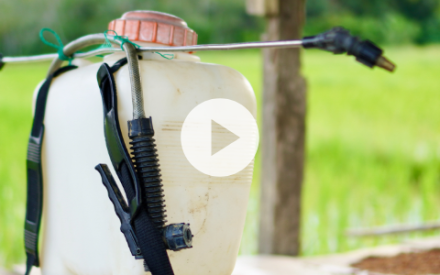This publication provides a starting point of reference when considering using cover crops following herbicides in the cropping system. It outlines rotational intervals for many commonly used herbicides in Wisconsin. However, it is important to note that this article does not replace the information provided on herbicide labels.
What is a rotational interval?
The rotational interval is the required amount of time from herbicide application to subsequent crop establishment for forage or harvest value. For example, if a herbicide is applied to soybeans with a 10-month rotational interval for winter cereal rye, the rye could be established 10 months after the herbicide application for food or feed value. This rotational interval is legally required period prior to crop harvest for feed or forage. Cover crops intended for forage value must follow the rotation interval. Cover crops utilized for building soil health do not need to follow the rotational interval; however, they may still be prone to herbicide injury. This herbicide injury is often attributed to herbicide carryover and the chances of injury can be better understood after a field bioassay.
The herbicide label must be referenced prior to making any management decisions. The rotational intervals stated in this publication are the maximum rotational restriction taken from the most current herbicide label available at time of production.
Herbicide Carryover and Cover Crop Establishment
For cover crops to accomplish their intended goals, they must establish well. The establishment of cover crops can be compromised by the soil residual herbicides initially applied to manage weeds in the preceding cash crop. The persistence of these residual herbicides may affect cover crop establishment later in the growing season and can be affected by a wide range of management (tillage, application rate, and herbicide application method) and soil properties (moisture, temperature, soil colloid properties, chemical reactions, pH, microbial population, soil texture and organic matter) (Krausz et al., 1992).
Cover cropping and using residual herbicides is not impossible but is challenging. Herbicide resistant weed management should be considered when planning herbicide applications. The cost of herbicide program, cover crop benefits, and resistance management should all be considered.
Cover Crops vs. Forage Crops
A crop is classified as a cover crop when no forage or grain biomass is harvested. A cover crop is established for benefits to the soil, cropping system, and environment. A cover crop becomes a forage crop when biomass is harvested for feed. This includes harvesting the crop via grazing or mechanical collection. A cover crop can be used for forage; however, most pesticide labels do not provide the plant back restriction time required from pesticide application to grazing or harvest for cover crops, only forage crops. Therefore, requiring the maximum rotational restrictions be utilized. If these restrictions are not followed, harvesting a cover crop for forage value is illegal.
Crop rotation restrictions will vary in length and should be examined for all pesticides and crops in the rotation. A cover crop that will not be harvested for any value can be legally established following any herbicide application, however, the grower takes all responsibility for cover crop injury or failure that may result. Several herbicide labels provide guidance for using cover crop following application. A bioassay is often recommended to evaluate herbicide injury potential.
Winter Cereal Rye Termination for Forage Systems
Winter cereal rye is often harvested as forage and questions arise when the rye should be terminated prior to the subsequent crop. Pre-harvest termination treatment is often illegal. Harvesting winter rye without another termination treatment is effective at reducing biomass and slowing regrowth; however, a second termination method is often required. Chemical treatment of rye regrowth, which may include residual herbicides for the following crop, should accommodate the pre-harvest interval, plant back restrictions for the subsequent crop and not have an antagonistic effect on the rye termination. Post-harvest glyphosate treatments are effective and legal methods of terming winter rye, and these applications can occur immediately following harvest
with no reduction in efficacy.
Using Bioassays to Measure Residual Herbicides
A field bioassay is often required or recommended prior to establishing crops following residual herbicide application. A bioassay is a test that measures the effects of residual herbicides in the soil on a crop in a controlled trial. Herbicide residues may vary in strength and be variable thought the field depending management and environmental conditions. A few variables include soil texture, pH, and drainage. A bioassay should be done using the typical management practices for the crop to be planted following herbicide application.
Two types of bioassay may be recommended. The most common, field bioassay, is done by using a small area of the field to plant a small trial area of the intended crop. This crop should be monitored for injury symptoms, stand reductions, reduced biomass/grain production. If injury occurs, extend the rotational interval to the next growing season. If the cover crop planted is for soil building and will not be harvested, a small tolerance for injury may be acceptable.
The second type of bioassay is done in a controlled setting. This includes collecting a small amount of treated soil from the field and placing in pots. These pots should be in a controlled environment (near a window and heated indoor area). The intended crop should be planted in these pots and observed for herbicide injury. More info can be found in “A Quick Test for Herbicide Carry-over in the Soil” (Klein et al. 2008). A bioassay does not replace the rotational interval.
Crop Variety and Hybrid Sensitivity to Herbicides
The data presented in this publication shows the rotational cropping intervals for common Wisconsin forage, grain and cover crops. Hybrids and varieties make a difference in herbicide tolerance. Genetic engineering allows crops traditionally injured by some herbicides to allow over the top applications and limited plant back restrictions. Always understand what traits and tolerances are in being used in your cropping system.
When using maximum rotational restriction interval data tables, use these ground rules:
- Always read, follow, and understand the herbicide label. The label is the law.
- These data are intended to be an introduction to herbicide rotational intervals; always consult the label before making management decisions.
- Maximum rotation length is shown; ration length is often dependent upon herbicide application rate, tillage, soil type, and yearly rainfall.
- The data are formulated for Wisconsin producers and utilize rotational data for areas that receive 30+ inches of precipitation per year.
- Some herbicide rotations do not consider frozen soils to count towards the minimum rotation interval; consult the label to clarify this information.
Interested in just alfalfa? Check out our alfalfa rotation restriction tables.
Download, print, or scroll through the full PDF publication below for maximum rotational restriction interval data tables and citations.

 ▶ Combine Cleaning: A Simple Step to Reduce Weed Seed Dispersal
▶ Combine Cleaning: A Simple Step to Reduce Weed Seed Dispersal Johnsongrass in Wisconsin
Johnsongrass in Wisconsin ▶ Backpack Sprayers in Diversified Vegetable Systems
▶ Backpack Sprayers in Diversified Vegetable Systems ▶ AI in Agriculture
▶ AI in Agriculture


